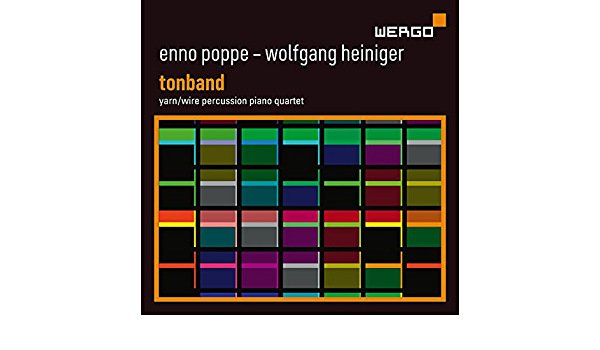The Music of Enno Poppe

It was fascinating to see, last Thursday evening (September 9) the Lucerne Festival Contemporary Orchestra in the German Premiere of Rebecca Saunders' piano concerto ... to an utterance at the Phiharmonie in Berlin; the soloist was Nic Hodges. The concert was conducted by Enno Poppe, better known in the UK (if at all) for his compositions. The new music scene in Berlin is vibrant and alive; and Poppe has been part of that scene since his arrival there in 1990. What was impressive about his conducting was his complete grasp of the score (taken on at late notice after a cancellation) - the orchestra clearly respected him thoroughly. Even more impressive was that he was a relacement - for an indisposed Ilan Volkov.
So here we present one and a bit discs of his music (the one below is shared with a piece by Wolfgang Heiniger, and one piece is co-composed). First, a disc on BR-Klassik, a label we have met several times before.
The first piece we meet is Fett for orchestra (1018/19, scored without percussion - unusualy in contemporary music!). Poppe himself descrives the work as having a "touch of Feldman" in the reduced means he uses. The music pulses, its chords changing slowly, as if revolving in front of us, and moving from the silvery opening to the climax of the very final moments. It's a score which requires huge control from its orchestra
A sort of post-Mahlerian processional that actively uses microtonality (intervals less thna a semitone) as part of its expressive/harmonic vocabulary, the piece operates at once as an impactful statement on its own merits while, as Poppe himself states, providing the copmsoer with material to work with for decades to come. What strikes me is the sheer beautt of the sonorities. There are moments when a melody emerges (on lower strings), adding a sense of forward movement.
The second piece on this disc is Ich kann mich an nichts erinnern (2005-15, "I can remember nothing") an arresting piece for orchestra (with organ) to a text from Michael Beyer's "Fünf Zeilen" from Erdkunde. Here's the first movement: listen to how when the organ enetrs the music seems to light up from within:
This feels like an alternative manifestation of the power that infused Fett but, there, gew; here its muscularity is there form the very start. The idea of a cantata is clearly here, but the balance between choir and orchestra is different - they interact and merge in a way the traditional cantata rarely explored. Once again beauty is very much part of the equation - as in the last two movements, building from the penultimate one:
... and so to the second disc:

Poppe's Feld for two pianos and two percussionists receives a vibrant performance from the New York group Yarn/Wire. Although identifiably from the same composer, this is another world entirely, brigher, with the two percussionists treated as sort of extensions of the pianos. Approximately 90% of the percussion parts come from marimba and xylophone. There is also an aspect of the piece as an encyclopaedia of gestures, from diminished seventh-Romanticism to gestures reminiscent of early silent film music. The second movement begins quietly, with a sort of impresiosn of a "weaving machine," so mechanistic is the music.
There is a plea for the reader of the booklet notes not to read them (!) until one has heard the co-composed piece Tonband (Poppe and Wolfgang Heiniger). So let's hear it! (it spreads over two YouTube videos):
Poppe has referred to Karlheinz Stockhausen's seminal piece Kontakte (1958-60; a magnificent piece of music, incidentally) as a "reference piece" for Tonband; I wonder if there isn't an element of tribute here, also. Here's Kontake (I have chosen a filmed performance as there is a real visual aspect to the piece):
In the Poppe/Heiniger piece, there is a stripped-down methodology: percussionists produce sounds and the pianists work exclusively with those sounds; electronic sounds are only heard when the percussionists are playing. The gestation of the piece occured with Poppe as pianist and Heiniger as percussionist and over a period of several days theey experimented. Poppe principally compsoed movements one and two, plus designed the notation used. Heiniger composed movements 3-5, and developed the electronics.
Finally, Neumond (New Moon) by Wolfgang Heiniger, composed for the present group. Two percussionists (who occasionally sing) are joined by two MIDI keyboards programmed with historical electric organ sounds. Although this post principally concerns Enno Poppe, it is only right to rpesent Heiniger's work. Based essentially on slow, drawn-out glissandi, and here utilising not quarter-tones, but sixth-tones in the harmonies, this short piece continuously plays with our sense of perspective. Both melody and humour play a part in this delightful piece, the perfect close:
